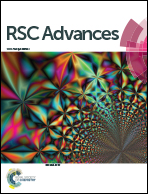Facile synthesis of a two-dimensional layered Ni-MOF electrode material for high performance supercapacitors†
Abstract
Recently, various metal–organic framework (MOF)-based supercapacitors (SCs) have received much attention due to their porosity and well-defined structures. Yet poor conductivity and low capacitance in most MOF-based devices limit their wide application. As an electrode material, 2D MOFs exhibit a rapid electron transfer rate and high specific surface area due to their unique structures. In this work, a 2D layered Ni-MOF is synthesized through a simple solvothermal method and serves as an electrode material for SCs. Electrochemical studies show that the Ni-MOF exhibits low charge transfer resistance, excellent specific capacitance of 1668.7 F g−1 at 2 A g−1 and capacitance retention of 90.3% after 5000 cycles at 5 A g−1. Moreover, Ni-MOF//AC asymmetric SCs are assembled. The device exhibits high specific capacitance of 161 F g−1 at 0.2 A g−1 and the energy density reached 57.29 W h kg−1 at a power density of 160 W kg−1. The high electrochemical performance can be ascribed to the inherent porosity of MOFs and the 2D layered structure.



 Please wait while we load your content...
Please wait while we load your content...